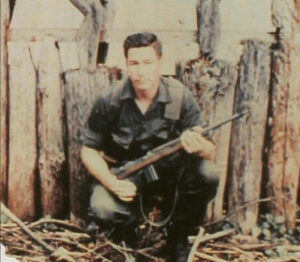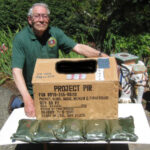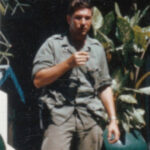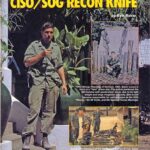Ben Baker
CISO

Conrad “Ben” Baker & CISO
Conrad “Ben” Baker was part of General Douglas MacArthur’s headquarters staff during WW2. A savant at navigating and energizing the military procurement system, Baker served in the Pacific supporting the Engineers. By 1963 he was stationed in Okinawa alongside Special Forces Captain David Watts as part of the Counterinsurgency Support Office (CISO). Baker served as Deputy Director of CISO from 1963 until 1972. He drove procurement for special operations forces in theater throughout the Vietnam War.
Baker, a WW II veteran who served briefly in General Douglas MacArthur’s headquarters staff before putting his skills at organization and logistics to work with Field Engineers. In 1963 he was working in Okinawa when Special Forces Capt. David E. Watts worked to develop the Counterinsurgency Support Office (CISO) in anticipation of needing to equip thousands of CIDG troops as the Vietnam War escalated. A key figure within CISO, and nowadays synonymous with the organization, was Conrad ‘Ben’ Baker who served as the Deputy Director from 1963 to 1972.
Ben Baker was technically a REMF. If you aren’t familiar with that term then Google is your buddy. However, in contrast to many comfortable rear-area support pogues, Baker took his job very, very seriously. He made more than 80 excursions downrange to forward base camps deep in the suck to find out straight from the users just what they needed to accomplish their dangerous unconventional missions. Along the way, he laid the foundation for modern practical military procurement.
Baker played an instrumental and hands on roll in the research, development and production of new highly specialized weapons, uniforms and equipment. The end users principally being US Special Forces, SOG, other Federal Agencies and indigenous forces operating within and from the Republic of Vietnam.
Travelling up and down Vietnam with more then 80 trips to forward base camps in- country, Baker also spent time in Thailand, Japan and Australia in an effort to find the most effective suppliers of materiel. Part of CISO and Baker’s immense value was their ability to provide support that was both within and outside of normal military channels without the interference of power politics which was rife within the military procurement process. As Baker himself said in an interview “We had no ‘must buy American’ mandates. Our job was to get the best supplies needed for our troops, plain and simple”.
Part of CISO’s success was also their insistence on listening to the wants, desires and needs of the men in the field and not “some fat-assed bureaucrat sitting behind a desk at DoD or the White House” and then putting these requirements into practice, ensuring the troops received the items they required within practical reason.
Within SOG, Baker is a legend for many reasons, including his unique inventions and items he purchased and refined with the SOG Recon Teams for their operational use. Some of CISO and Baker’s inventions and purchases include, but are not limited to:
– Seiko watches.
– Gloves.
– Machetes.
– Specialized ammunition pouches.
– Replicas of enemy uniforms and equipment.
– Sleeping bags.
– Ponchos and liners.
– Rucksacks that were appropriately designed for indigenous troops.
One of Baker’s most brilliant contributions took the unlikely form of the PIR Indigenous Rations. Native Montagnard’s were getting the runs from eating their US rations, designed for typical Western dietary requirements, so Baker went to Vietnam and Laos to talk to a number of nutritionists. After a period of consultancy, Baker came up with the indigenous rations which consisted of pre-cooked rice laced with Vitamin B to counter the vitamin deficiency that was often found within the indigenous troops. Baker sourced the pre-cooked rice from Taiwan and developed several rice seasonings; beef, fish, squid and mutton to name a few. When trying to produce the rations on a mass scale, he went to the US Navy Laboratory only to be told it would take 2-3 years to produce the ration. Systematic to the US Military’s procurement process, the timescale was unacceptable to Baker and he went to a private company, placing an order for 30,000 meals for a Dollar a piece. By the end of the Vietnam War, Baker estimated that CISO had sent 66 million rations that were used by the U.S and its allies in Vietnam, Laos, Thailand and in other locations.
Ben Baker was also responsible for Inventing the first SOG Knife. When designing the knife he tested different types of steel for their suitability and worked on various blade and handle designs. Baker looked to his Father’s Marble Gladstone hunting knife for inspiration, he wanted to keep the design simple but effective. The blades designs are unique but bare resemblance to the classic American Bowie designs which are synonymous to strength and practicality. The first order for 1,300 SOG Knives went to Yogi Shokai, the Japanese trading company based in Okinawa that CISO worked with at the time. The order was made in 1964 for a seven-inch knives and eight prototypes that cost $9.85 a knife. These knives went to SOG teams for cross-border operations for testing and evaluation. Over the course of the Vietnam War, Baker designed a six inch knife and a seven inch knife for US Special Forces and SOG teams. He also made a prototype dive knife for SOG, of which only forty were made.
The key to Baker’s effectiveness was his willingness and enthusiasm to accomplish the mission independent of military bureaucracy. By living and working near the front Baker could remain responsive. Unfettered from the cumbersome Army procurement system, he just did whatever it took to get the gear his guys needed. In his own words, “We had no ‘must buy American’ mandates. Our job was to get the best supplies needed for our troops, plain and simple.”
Baker’s best-known creation was the SOG knife. We’ll explore that in detail in a moment. However, what really had the most profound impact was likely his PIR indigenous rations.
Baker consulted nutrition specialists in-country in both Laos and Vietnam to determine the sorts of foods that would be amenable to long-term storage and use by indigenous troops. The end result was pouches of pre-cooked rice fortified with Vitamin B. Baker sourced the rice from Taiwan and included seasonings derived from mutton, fish, beef, and squid. When Baker approached the US Navy food research lab with the problem he was told it would take between 2 and 3 years to develop the rations and packaging required to get this food into the field.
Combat troops of all stripes need a good knife. Special operators can live or die by such steel. As the Vietnam War was ramping up SOG men clearly needed something other than the GI-issue bayonet. Ben Baker used his dad’s Marble Gladstone hunting knife as a template.
Those first SOG knives took inspiration from the classic American Bowie. This field-proven design was renowned for its strength and effectiveness. Baker contracted for the first 1,300 SOG knives from the Japanese trading company Yogi Shokai in Okinawa for $9.85 each. As you might imagine, original copies go for a bit more than that these days.
Before the war wound down Baker had designed both 6 and 7-inch combat knives for the SOG teams. He designed a prototype dive knife as well, but very few of them were made. The basic SOG knife remains popular around the world among soldiers and woodsmen even today.
During his many forays downrange Ben Baker typically carried a selective-fire M2 carbine mounted in an M1A1 side-folding paratrooper stock. This compact weapon was easy to carry, particularly in and out of helicopters. When fitted with a 30-round magazine the rifle actually offered more on-tap firepower than the early M16 variants sporting their 20-round boxes. The M1A1 was a specialized adaptation of the then-revolutionary WW2-vintage M1 Carbine.
Ben Baker was a dedicated and gifted soldier whose forte was getting the right gear into the hands of those who needed it by any means necessary. Though not technically a special operator himself, he was inducted as an honorary member of the US Army Special Forces Regiment. At the time he was only the 12th non-SF individual to be so honored. He passed away in December of 2019, a legend among American special operators everywhere.










